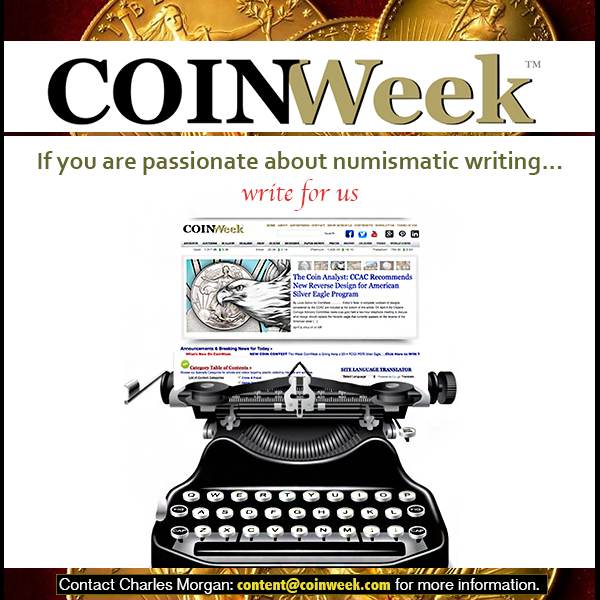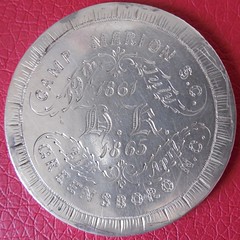
PREV ARTICLE
NEXT ARTICLE
FULL ISSUE
PREV FULL ISSUE
PETER BERTRAM ON DAVIS FLIGHT MEDALS
Peter Bertram submitted these notes in response to Alan Weinberg's item in last week's issue. Thanks!
-Editor
I feel I must begin by saying that I hold Alan Weinberg in very high esteem and greatly respect his knowledge and experience. Also, this is one of the few opportunities I’ll have to publicly thank him for his generous permission to include the Davis Flight Medal images from his fabulous collection in my forthcoming book. It is with regret, therefore, that I must respectfully disagree with his comments in last week’s E-Sylum. First off, no dispute with his opening comment. He does indeed have the most impressive collection of coins with Confederate engravings on them that I’ve ever seen! But then he notes: “All of the specimens in my collection….were hand-engraved by the same skilled artisan whom, it may be reasonably assumed, was camped outside of the Greensboro surrender like a Sutler, and engraved departing Confederate soldiers' take-home pay coins for a small price”; and in the next paragraph: “all mine and most others seen are all engraved by the same hand (easily discerned) and all very specifically dated down to the day - the 25 or 26th”. For purposes of the discussion at hand, we are only interested in documenting the Davis Flight medals. Unless he has acquired additional specimens, four of Mr. Weinberg’s Confederate engraved coins fit this criteria and they are from the surrender of Gen. Johnston’s Army in North Carolina.
The officers tried to distribute it as equally as possible so most soldiers received between $1 and $1.60, all they had to show for four years of war! After being paid and receiving their paroles, many of the men started home, but some banded together in acts of violence and lawlessness. There were riots in Greensboro, prompting Governor Vance to issue a proclamation urging citizens to “abstain from any and all acts of lawlessness”. So the Confederacy was dying and I suggest it’s difficult to imagine normal commerce resuming in such an environment of civil unrest. I do not think it may be at all “reasonably assumed” that someone was camped outside of Greensboro hand engraving coins for soldiers. 1) There was no surrender at Greensboro like at Appomattox. Gen Johnston’s troops got their pay and their paroles where they camped, widely scatted around the countryside. Did the “Sutler” thus go from campsite to campsite seeking business? 2) Two of Mr. Weinberg’s Davis Flight medals are dated April 26th at Greensboro, another is dated April 25th with no location, and the fourth is dated April 26th at High Point. Mr. Kaminski’s specimen is dated April 27th at Greensboro and I have an image of another very ornate specimen dated April 26th at Charlotte. I would tend to suggest the April 25th piece with no location is most likely from a unit in the vicinity of Greensboro, simply because those were the largest units (Corps size). Do the specimens from High Point and Charlotte suggest that our “Sutler” was obliged to move around quite a bit? I also have specimen images from May 4th, May 7th, and May 10th (Union piece), but they resulted from other activity and are not related to the surrender pieces. 3) Examining all nine of the Davis Flight medal images that I have, I find it really difficult to imagine any two of them being engraved by the same person. Different script styles, different block letter styles, different styles of flourishes, etc, etc, no two alike or even all that similar! I therefore suggest it is most certainly not “(easily discerned)” that all were engraved by the same hand. 4) With regard to the coins being “all very specifically dated down to the day - the 25 or 26th”, of course they are – that’s the day the soldier was paid – why would he use any other date? 5) Lastly, suggesting that surrendered “rag-tag Confederate soldiers” couldn't keep a silver coin for years as a souvenir may have been appropriate for many of the veterans. But it is also the reason why we are only aware of six Confederate engraved specimens surfaced to date out of some 32,000 soldiers paid. Here’s two quick comments on the subject: - Confederate Captain Stoney wrote at Greensboro: "The brigade was paid today one dollar and a quarter in silver per man, the last I suppose of the Confederate treasury. I shall have mine made into a medal to keep and value as received from the dying hands of my government”. -General Beauregard remarked some years later that he still had his share, “planning to have a small medal made of it as a memento of the last days of the Confederacy”. Regrettably neither Stoney's nor Beauregard's coin have yet surfaced.................... In closing, I must admit I have a very strange attitude – I love to be proven wrong, especially in a discussion like this because then what emerges? Why – the truth, of course! So if Mr. Weinberg can offer documentary evidence of a Sutler or skilled artisan engraving coins at Confederate camps near Greensboro, NC at the end of April, 1865, I would love to see it! I would hasten, with great rapidity, to humbly retract my position and confess the error of my ways. With continued respect and esteem for Mr. Weinberg, I suggest that until that time we’ll be obliged to congenially agree to disagree. -Davis, Burke: The Long Surrender; Random House, Inc; New York, NY; 1985 -Dunkerly, Robert M: The Confederate Surrender at Greensboro; McFarland & Company, Inc. Jefferson, North Carolina; 2013 -Parker, William Harwar; Recollections Of A Naval Officer 1841-1865; Charles Scribners Sons; New York; 1883 To read the earlier E-Sylum article, see: ALAN WEINBERG ON DAVIS FLIGHT MEDALS (www.coinbooks.org/esylum_v17n16a20.html)

Wayne Homren, Editor The Numismatic Bibliomania Society is a non-profit organization promoting numismatic literature. See our web site at coinbooks.org. To submit items for publication in The E-Sylum, write to the Editor at this address: whomren@gmail.com To subscribe go to: https://my.binhost.com/lists/listinfo/esylum All Rights Reserved. NBS Home Page Contact the NBS webmaster 
|
